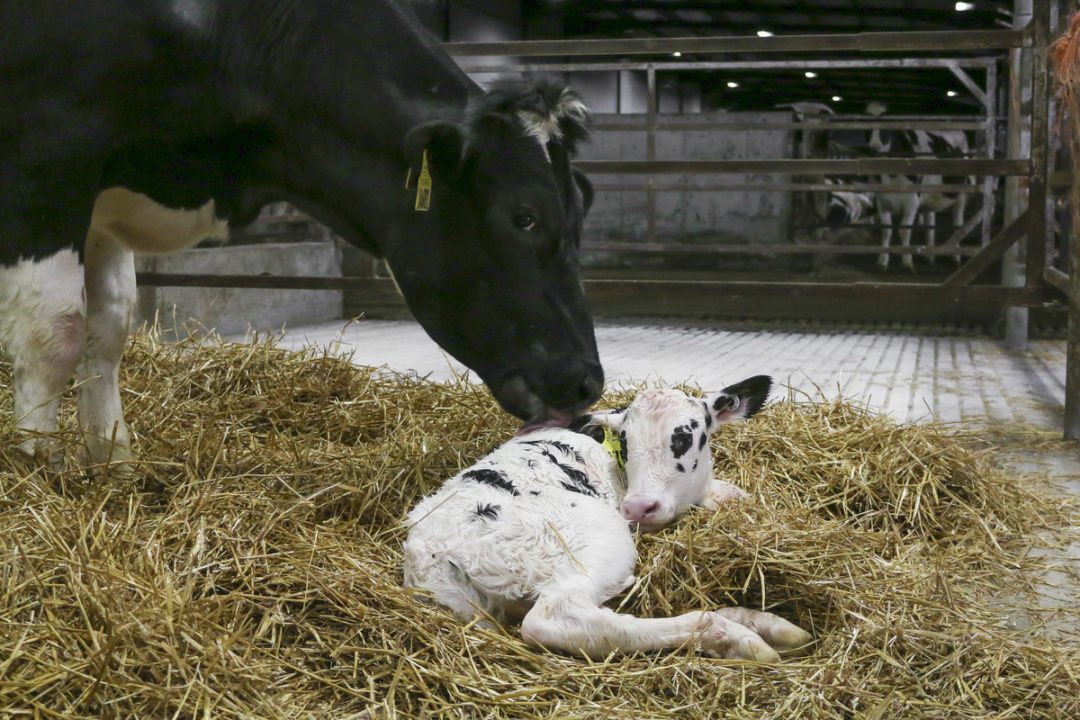It is a pretty exciting time in the field of milk fever prevention. New products, new strategies and new research are here – giving dairy producers more options to prevent milk fever and subclinical hypocalcemia. Historically, milk fever prevention programs attempted to directly alter the calcium status of dairy cows at calving. Historic approaches included feeding pre-fresh dairy cows diets containing anionic salts, restricting dietary calcium, feeding high levels of dietary calcium and administering calcium boluses and pastes post-calving. Progress has been made, but challenges still exist.
So what is the new research – the new strategies? Well, over the past decade, research has given us a much better understanding of the role dietary phosphorus plays in the prevention of milk fever and hypocalcemia. Dairy scientists working in the field of milk fever prevention have long known that feeding excessive levels of dietary phosphorus pre-calving was interfering with calcium balances of dairy cows at calving. Or alternatively, feeding excessive dietary phosphorus was increasing the risk of milk fever, but no practical on-farm management practices emerged from that knowledge. That has changed.
Enter zeolite A
Zeolite A is produced synthetically and is now commercially available to feed pre-fresh dairy cows. Feeding dairy cows zeolite A prepartum has been explored as a feeding strategy to reduce hypocalcemia and prevent clinical milk fever for the past two decades.
In early studies, feeding synthetic zeolite to pre-fresh cows was shown to elevate blood calcium at calving and reduce the incidence of clinical milk fever, but scientists were a bit confused as to mode of action. At the time, they hypothesized zeolite A was binding dietary calcium and thereby decreasing calcium availability, much like previous research done. Limiting calcium availability would cause cows to elevate parathyroid hormone and active forms of vitamin D, inducing bone mobilization of calcium and improving intestinal absorption of calcium prior to calving. This initial hypothesis turned out to be false, as the researchers could never clearly establish the calcium binding theory.
What was clear in the early and all subsequent zeolite A studies was feeding synthetic zeolite to pre-fresh cows was consistently reducing blood phosphorus levels prior to calving. Further, it was shown blood phosphorus reductions were always naturally associated with elevated blood calcium levels at calving and reductions in clinical milk fever.
More detailed aspects of these studies revealed that bone mobilization and activation of hormonal vitamin D in pre-fresh cows was being initiated by phosphorus balance. As it turned out, responses to feeding pre-fresh dairy cows zeolite A in combination with moderated dietary phosphorus appear nearly identical to studies in which dietary phosphorus was purposely restricted to pre-fresh cows – which also reduced clinical and subclinical hypocalcemia.
A recent study at the University of Wisconsin – Madison observed reduced clinical and subclinical hypocalcemia even as compared to feeding pre-fresh cows negative DCAD-based diets. These researchers also demonstrated that feeding synthetic zeolite was reducing the amount of recycled phosphorus in the saliva and increasing the amount of undigested phosphates in the feces.
Feeding synthetic zeolite to pre-fresh dairy cows for the prevention of milk fever and subclinical hypocalcemia now has widespread use among dairy producers. There are, however, key management aspects associated with feeding zeolite A to increase its chances of success.
First, the management team on the dairy including the owner, herdsman, nutritionist and attending veterinarian will require a bit of a paradigm shift. Transient blood phosphorus values will be observed (2 to 3 milligrams per deciliter is common) immediately after calving and then will rise quickly to 4 to 6 milligrams per deciliter within 24 to 48 hours. This is simply the transient phosphorus mechanism at work – it is required to signal the cow to mobilize bone and activate vitamin D prior to calving.
Second, don’t overfeed zeolite A. Synthetic zeolite feeding levels need to be balanced with dietary phosphorus levels.
Third, don’t feed synthetic zeolite too long. Cows only need to be fed zeolite A for approximately a week prior to calving, but due to the inability to predict an actual calving date, feeding synthetic zeolite for 14 to 21 days prior to the projected calving date is commonly recommended.
Fourth, make sure the zeolite is mixed properly in the diet.
Feeding zeolite A to prevent milk fever and subclinical hypocalcemia has some advantages relative to feeding DCAD-based diets to pre-fresh cows, but it also has some disadvantages. When pre-fresh cows are fed synthetic zeolite, urine pH does not need to be monitored. Likewise, low-potassium forages do not need to be procured or purchased because synthetic zeolite works to prevent milk fever through a different mechanism. Many dairy producers like the aspect of being able to use higher-quality homegrown forages in the pre-fresh diet to reduce supplemental protein cost. Many dairy producers also report a significant reduction in the use of calcium boluses, but there are no research data to support these observations.
The disadvantages of feeding synthetic zeolite include the inability to use the technology in a one-group dry cow situation. Also, if cows are in the pre-fresh pen for long periods of time (greater than 28 days), a traditional DCAD program may be a better fit. Likewise, the technology will not likely work well in overcrowded pre-fresh pens.
More on the horizon
Researchers at the University of Wisconsin – Madison are also working with a compound called 5-HTP. 5-HTP is a form of the amino acid tryptophan and is an intermediate in the production of serotonin, which has been shown to stimulate the making of a compound called parathyroid hormone-related protein. This is yet another pathway in which blood calcium levels of dairy cows can be modified or improved at calving.
Researchers are also working on administering Solanum glaucophyllum, which contains the active form of vitamin D (1,25-dihydroxyvitamin D3). Administration of Solanum glaucophyllum has also been shown to increase blood calcium levels.
Finally, researchers are working on additional products to increase calcium absorption from the intestine.
These products are all in stages of commercial development, so stay tuned.











